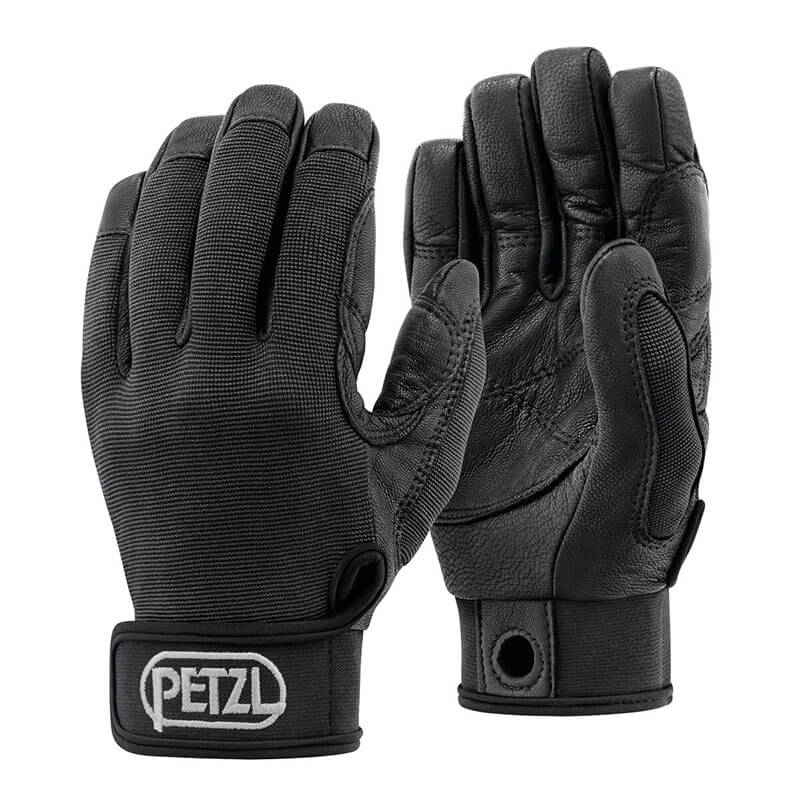Description
25% off all Petzl fall protection gear: No promo code required. All prices are already discounted and cannot be combined with other offers. For a limited time only, while supplies last. Offer limited to what's currently in stock.*
Keep your hands protected while working outdoors or performing rope access work with the CORDEX Lightweight Belay and Rappelling Glove from Petzl, made with reinforced goat leather. Durable yet comfortable, the glove features reinforced palms which make them ideal for anyone regularly handling ropes.
Key Features:
- Ergonomic cut for great dexterity without being too tight
- Made of high quality leather for the perfect balance between durability and dexterity
- Durable double layer of leather in high-wear areas: fingertips, palm, between thumb and index finger
- Back made of breathable stretch nylon for excellent fit and ventilation
- Neoprene cuff with Velcro closure
- Carabiner hole to attach gloves to harness
Who Uses This: Tower climbers and technical rescue workers needing durable protection for their hands while working at heights or outdoors.
Why We Recommend It: Goat leather is soft without sacrificing durability, making these gloves very comfortable to wear. The two layers of leather on the palm provide you with an incredibly rugged glove that's ideal for rope access and belaying. The cut allows for easy natural hand movement and sensitivity.
Safety Standards Met:
CE EN 21420, CE EN 388 (3123), UKCA, EAC
Total Weight: 3.5 oz. - 4.2 oz.
Product Numbers:
K52 SN - Small Black
K52 MN - Medium Black
K52 LN - Large Black
K52 XLN - XL Black
K52 ST - Small Tan
K52 MT - Medium Tan
K52 LT - Large Tan
K52 XLT - XL Tan
Related Searches
Fall Protection,
Leather Safety Gloves,
Petzl,
Safety Gloves
Read more
Description
25% off all Petzl fall protection gear: No promo code required. All prices are already discounted and cannot be combined with other offers. For a limited time only, while supplies last. Offer limited to what's currently in stock.*
Keep your hands protected while working outdoors or performing rope access work with the CORDEX Lightweight Belay and Rappelling Glove from Petzl, made with reinforced goat leather. Durable yet comfortable, the glove features reinforced palms which make them ideal for anyone regularly handling ropes.
Key Features:
- Ergonomic cut for great dexterity without being too tight
- Made of high quality leather for the perfect balance between durability and dexterity
- Durable double layer of leather in high-wear areas: fingertips, palm, between thumb and index finger
- Back made of breathable stretch nylon for excellent fit and ventilation
- Neoprene cuff with Velcro closure
- Carabiner hole to attach gloves to harness
Who Uses This: Tower climbers and technical rescue workers needing durable protection for their hands while working at heights or outdoors.
Why We Recommend It: Goat leather is soft without sacrificing durability, making these gloves very comfortable to wear. The two layers of leather on the palm provide you with an incredibly rugged glove that's ideal for rope access and belaying. The cut allows for easy natural hand movement and sensitivity.
Safety Standards Met: CE EN 21420, CE EN 388 (3123), UKCA, EAC
Total Weight: 3.5 oz. - 4.2 oz.
Product Numbers:
K52 SN - Small Black
K52 MN - Medium Black
K52 LN - Large Black
K52 XLN - XL Black
K52 ST - Small Tan
K52 MT - Medium Tan
K52 LT - Large Tan
K52 XLT - XL Tan
Related Searches
Fall Protection,
Leather Safety Gloves,
Petzl,
Safety Gloves
25% off all Petzl fall protection gear: No promo code required. All prices are already discounted and cannot be combined with other offers. For a limited time only, while supplies last. Offer limited to what's currently in stock.*
Keep your hands protected while working outdoors or performing rope access work with the CORDEX Lightweight Belay and Rappelling Glove from Petzl, made with reinforced goat leather. Durable yet comfortable, the glove features reinforced palms which make them ideal for anyone regularly handling ropes.
Key Features:
- Ergonomic cut for great dexterity without being too tight
- Made of high quality leather for the perfect balance between durability and dexterity
- Durable double layer of leather in high-wear areas: fingertips, palm, between thumb and index finger
- Back made of breathable stretch nylon for excellent fit and ventilation
- Neoprene cuff with Velcro closure
- Carabiner hole to attach gloves to harness
Who Uses This: Tower climbers and technical rescue workers needing durable protection for their hands while working at heights or outdoors.
Why We Recommend It: Goat leather is soft without sacrificing durability, making these gloves very comfortable to wear. The two layers of leather on the palm provide you with an incredibly rugged glove that's ideal for rope access and belaying. The cut allows for easy natural hand movement and sensitivity.
Safety Standards Met: CE EN 21420, CE EN 388 (3123), UKCA, EAC
Total Weight: 3.5 oz. - 4.2 oz.
Product Numbers:
K52 SN - Small Black
K52 MN - Medium Black
K52 LN - Large Black
K52 XLN - XL Black
K52 ST - Small Tan
K52 MT - Medium Tan
K52 LT - Large Tan
K52 XLT - XL Tan
Related Searches
Fall Protection,
Leather Safety Gloves,
Petzl,
Safety Gloves
Specifications
Specifications
-
MPN
-
Product Weight (lbs.)
-
Height (in.)
-
Length (in.)
-
Width (in.)
-
Country of Origin
Reviews
Reviews
Keep your team protected & compliant!
- Expert guidance tailored to your specific needs
- Access responsive customer support when you need it
- Enjoy fast shipping directly to your location
- Benefit from extensive industry knowledge—75+ years of experience
- In-house gas detection calibration & repair services available






